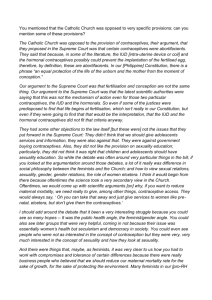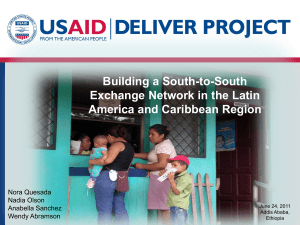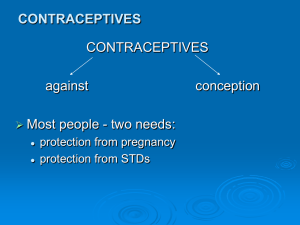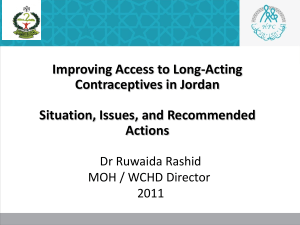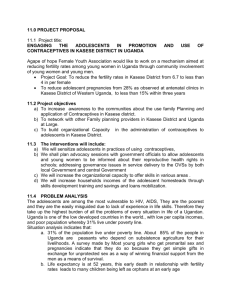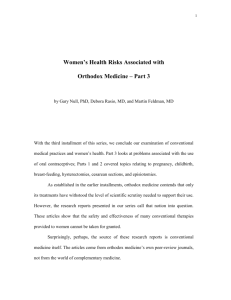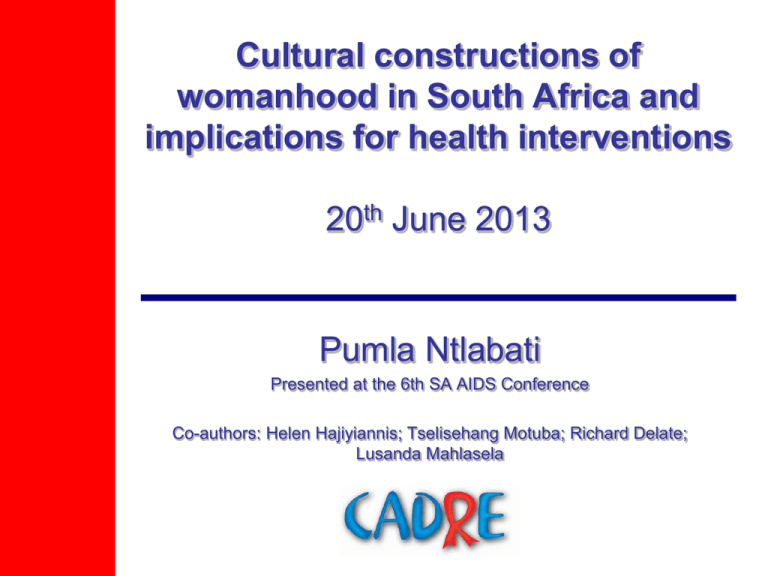
Cultural constructions of
womanhood in South Africa and
implications for health interventions
20th June 2013
Pumla Ntlabati
Presented at the 6th SA AIDS Conference
Co-authors: Helen Hajiyiannis; Tselisehang Motuba; Richard Delate;
Lusanda Mahlasela
Background and Context
In partnership with Johns Hopkins Health and Education in
South Africa and its partners (JHHESA), CADRE conducted
research to examine societal constructs of womanhood,
especially those that place pressure on women to conform,
putting their health at risk.
Findings would inform design and content of the national
Women and Girls’ campaign, aimed at empowering women to
get a sense of the kind of strength that will enable them to
draw their own boundaries, and to take control of their lives,
their health and their futures.
The campaign aims to move beyond HIV interventions to
encompass sexual and reproductive health (SRH) issues, and
focuses on teenage pregnancy, sexual reproductive health
(family planning) and Prevention of mother-to-child
transmission (PMTCT).
The campaign is evidence-based, is informed by research, and
is also in line with international sexual and reproductive health
guidelines and developmental goals pertaining to women.
Objectives
To examine local and cultural perceptions of
womanhood;
To understand how society, and how women define
themselves;
To understand how the role of women has historically
been determined (often within cultural boundaries);
To understand how societal constructs of womanhood
can be perpetuated by men and women;
To examine beliefs and ideas about the essence of
femininity and perceptions and expectations of women
across South Africa;
To understand how these definitions impact on choice
and utilisation of opportunities to control women’s
own health outcomes.
Methodology
Five focus groups were conducted in four South
African provinces.
The provinces included equal representation of
women living in urban, peri-urban and rural
localities.
Males were included in two of the five focus
groups.
Focus group participants were aged 20 to 40
years.
Groups were conducted in: Welkom (Free
State), Maruleng (Limpopo); Johannesburg
(Gauteng), Umlazi and Bulwer (KwaZulu-Natal).
Sample discussion questions
Who is considered a woman in your community?
What does it mean to be a woman?
What is your understanding of the roles of women?
What is expected of women in this community?
How do women in this community talk about their sexuality?
What are community expectations of women and motherhood?
Who determines how many children a woman has and when she has
them?
What challenges do women in your community face?
What kind of issues that affect women would you like to see addressed?
Where do women get their strength from or what is the source of a
women’s strength?
How do women show their strength? How do women NOT show their
strength?
What are advantages and disadvantages of women being on
contraceptives?
What are the attitudes in this community towards women who are on
contraception?
What is the best way to communicate information about contraception
to women?
Defining women
Definitions of a woman appear similar across all sites, with specific
values and behavioural attributes attached to them.
These include age, physical and emotional development,
behaviour/deportment, dress, and values exuded.
I think a person is a child before they reach that stage of being a woman, it
starts by physical changes thereafter... The body develops breasts and other
changes, and basically at that stage a person realises that they have to
change, due to these physical changes they have to adjust how they
behave as a woman, because there is a difference between a girl and a
woman (Female, age 25, urban, KwaZulu-Natal).
Maturity as defined by experience, as opposed to age, also appears to
be a determining factor (e.g. children heading households).
I think it’s like different experiences that shape you to become a woman,
because different people go through different things, and we all like grow
and mature at different stages. So I mean a 19 year old girl could be more
mature than a 25 year old woman just because of the things that she’s been
through” (Female, age 20, urban, Gauteng).
Both men and women appear to subscribe to these values &
determinants.
Who determines when and how one
enters womanhood?
Determinants of womanhood are mostly imposed by the community
one grows up in.
…as you grow older you get taught specific teachings that help you grow up
into womanhood. When you enter into puberty you are taught that you
need to dress in a certain way, you will not play with boys and all those
things. …When you walk, you need to exude pride and show your positive
upbringing…. because a woman should behave this way...
…the way she behaves, the stuff she does, where she goes, who she
hangs out with, how she talks”. A well-mannered woman would “go to
movies, have lunch with friends, not go partying late, or doing something
bad like drugs and everything” (Male, age 22, urban, Gauteng).
Both the parents and the community hold a supervisory role in
terms of what is regarded as acceptable and what is not.
When I was growing up, my father did not allow me to wear trousers even
though wearing trousers was fashion that time, he said I should dress like
a girl (Female, age 34, peri-urban, Free State).
When I was young I was chubby, a fat child, I realised that my mom wanted
to dress me up in clothes that covered me up because I had a big body,
she explained that my body is not the same as of that of my peers, because
men are naughty now, in order to prevent any mishap you need to cover
up your body (Female, age 25, urban, KwaZulu-Natal).
Defining role & expectations
Formal and informal teaching of women about how to be a woman
are carried on through the stages of life: young girl; young woman;
getting married; becoming a mother etc.
Dignity; being strong, selfless, putting up with adversity, putting
others before self always; submissive to husband, have children; don’t
talk about issues; keep own pain hidden from children and others.
I think a girl becomes a woman when she starts becoming selfless… like
usually when you’re a girl, all you’re thinking about is …looking a certain way
…and then that changes when you become a woman and you start, I don’t
know, putting other people first... (Female, age 20, urban, Gauteng).
These values appear to survive through being passed on to girl
children by mothers as a way of ensuring that they know what is
expected of them as they take up their place as women.
When my sisters and I became teenagers, she sat us down and told us what
it means to be a woman, and she said, one thing that stuck to me was she
told us to always be strong. As a woman, you must always be strong. You
must know how to just get over things. Don’t ever try to act like a man; you
must always be a woman (Female, age 20, urban, Gauteng).
Defining role & expectations
Evidence of traditional notions of expectations and roles of women
was common across all groups; researchers had to sift through layers
of data and probing to get to ‘actual lived experience. E.g. Women are
seen to play a vital role in ensuring the smooth running of the home.
I think for example with me, like with my girlfriend, I would expect her to do
the cooking, I can’t cook, do the cooking and cleaning and stuff like that.
Obviously I would help her out now and again, but it’s because when I was
growing up, my mom used to do that for me. So what my mom did for me,
I expect a woman, my wife or girlfriend or whatever, to basically do (Male,
age 24, urban, Gauteng).
You become, I can say a house wife or you become submissive to your
husband. And you become a wife. You leave all the bad stuff and you
become, take the good stuff and you become…a woman (Female, age 21,
urban, Free State).
The sentiments expressed above appear to be in line with the role
society expects a woman to play, being a wife and looking after her
family.
When a woman fails to reach this goal this attracts reprisals and name
calling ‘lefetwa’ (spinster) from sectors of the community.
Defining role & expectations
There was dissent from respondents who did not think that this is
what women should aspire to, as there are clear disadvantages to
being married which cannot be ignored.
If a woman does not get married …she might be single, not married and
called belittling names but have enough capacity to build a house for
her parents. The community will look at her works and praise her works
as good example to others. This will make the woman feel appreciated.
Others might call her those belittling names but her works will speak
louder in the community. (Female, age 36, urban, Free State).
Still on a positive note, women are also seen as generally astute and
adept at finding solutions, both within and outside the immediate
environment.
Even if there is a child being abused in the house, let me say in my
house there is a child being abused, the first person who will see that
the child has a problem, is the female teacher at school (Female, age
36, urban, Free State).
For example, you can find that next door the woman has certain
problems, she will be the one who goes to consult with the social
worker and look for help outside (Female, age 24, peri-urban, Free
State).
Defining role & expectations
A further positive element noted is that what roles were traditionally
ascribed to men are now being attributed to women - spontaneously
describing them as ‘bread winners’ and ‘go getters’ who take full
charge of their lives. They were described as hard-working, ambitious,
independent, proactive and successful.
Women in Umlazi are hard workers, they do all they can to be
financially independent. Gone are the days where women feel that a
man has to earn more than me. These days sisters are doing it for
themselves, from a young age... Uhm...you get women who are in
charge in construction companies with big tenders and being
independent, helpful to others… they like creating opportunities for
others also. …Even if you can see the cars they drive, yoooh, men do not
even come close to what women are driving. If you see a Lamborghini
here, it’s being driven by a woman. It’s a good feeling as it encourages
us too, to want to get there (Female, age 34, urban, KwaZulu-Natal).
Women’s groups are also seen as powerful vehicles for change in
communities (e.g., stokvels, caregiver groups).
I think in the community as women, most things begin with the mother
figure. Something like social clubs, women are the ones who always begin
such things. Men always get advice from their women. Even if men can
initiate such a thing but women will always be at the forefront (Female, age
34, peri-urban, Free State).
Women’s sexuality: expectations &
decision making
Evidence of traditional notions of when women are expected to have
sex e.g., sex after marriage; sex when out of school also emerged. On
probing however, it was clear that this contradicts reality. (girls as
young as 11 and 12 are engaging in sex and are mothers).
Now lately in our communities, parents have accepted that kids are
having sex. They see with teenage pregnancy, a twelve year old would
fall pregnant these days. Parents know that their kids are having sex
with boys. There is no specific age to break virginity. Kids are having sex
unexpectedly (Female, age 25, urban, KwaZulu-Natal).
…now it is not frowned upon like before, but when 11, 12 and 13 year
olds started having children it was a huge scandal, but now it has been
normalised, they are not chased away from home. It is now common.
Parents now seek comfort in knowing the boy responsible for the
pregnancy. Because of the danger posed by abortion, parents opt to
allow them to have the baby, then that is fine (Female, 39, rural, KZN).
But nowadays a girl will pretend to be a virgin to the husband’s family,
yet she and her husband know that they have been practicing sex long
before marriage (laughter)…(Female, age 36, urban, Free State).
Motherhood: expectations & decision
making
Having a child is seen as very important across all sites.
…when you are a woman, you have to have children. When you are
without any children, you question that maybe something did not go
right. Why does she not have children when she is a woman? You ask
yourself such things. Maybe she is not a woman, she is something else
(Female, age 36, urban, Free State).
Generally, if you are a woman you have to prove your fertility, with
children seen as vital in carrying the family name forward.
Interviewer: So it’s very important to have a baby here. How old must
you be, when is the age when they start to insult you?
F3: At age 23, 24. It doesn't matter even if you are working or you are
not working, how you are going to support your child, it doesn't matter,
married or not married.
The pressure doubles when a woman is married.
Even the in-laws, what they want from you is children. They want to see
offspring from the family and if no offspring are produced they will start
saying to their son- even if they liked you before, they start saying what
are you doing with this person who doesn’t have children- we want
children. They actually encourage the man to go and have other
partners (Female, age 22, peri-urban, Free State).
Motherhood: expectations & decision
making
Differences were seen in decisions to have children:
Generally, older, mature couples make joint decisions on number of
children etc.
Some women report taking control of decisions on when and how
many children they have e.g. starting contraception secretly, having
hysterectomies etc.
When I delivered my girl and the doctor told me I had a baby girl, I told
him to sew me up (sterilisation). …I signed the form in theatre that I
want to stop having children. I did not discuss it with my husband; I
took the decision for myself as I had got the baby girl I had been
wanting all along (Female, 39, rural, KZN).
Younger women appear to make these decisions themselves, and
largely appear to be ruled by emotions.
I think basically – when you are young and you are in this phase of
‘first love’, you don’t think outside of the relationship. You don’t think
about effects of how having a baby will affect your lives at that
moment; it’s a case of being in love and living just for that. I know this
person and we are so much in love and the only thing to complete this
perfect picture is a child, that’s the only thing I can say. (Female, age
25, urban, KwaZulu-Natal).
Sex & sexuality:
Generally, parents do not talk directly to their children about sex
apart from discussions about safer sex and HIV. Most parents
respond to the situation by taking young girls to the clinic for
contraception as soon as they have their first period.
To add on what she said, when the mother sees that the daughter has
started menstruation she will take her to the clinic (Female, age 31,
urban, Free State).
HIV is an issue that has forced most parents to talk about issues to
do with sexuality, with messages mostly focusing on HIV
prevention.
Talking openly to partners about sexuality is approached
differently – some feel that a certain degree of trust has to exist in
the relationship for such open talk to be possible.
It depends on how comfortable you feel about the person. If I am not
close enough with my boyfriend, you know I won’t be open to him. I
would rather go and discuss with some of my friends. But if it is a person
I feel comfortable with and open to, I can talk to him about it (Females,
ages 21, 22, peri-urban, Free State).
Women in abusive relationships, are regarded as less able to
communicate to their partners.
Women’s sexuality & decision making:
e.g. Contraceptives
Common: pill, injection, condoms, morning after pill.
Less common: thigh sex, abstinence, virginity testing
(KZN); withdrawal method, female condom.
Other practices:
various stuff taken post sex to prevent pregnancy
(e.g. bicarbonate of soda, essence of life);
insert a sponge to absorb sperm;
muthi buried in the yard;
coloured string around the waist;
taking a shower;
cough or jump up and down to expel sperm;
abortion.
Women’s sexuality & decision making:
e.g. contraceptives
A number of beliefs shared across sites regarding the use of
contraceptives centred on the side effects of female contraceptives,
especially the injectable, and included:
Changes in body shape;
Changes in weight
Changes in menstrual cycle (prolonged, irregular or absent menstruation)
Contraceptives cause infertility or permanent damage
Female contraceptives have side effects on males e.g. hip pain.
Views by men on contraceptives differ: while in one province men view
this as responsible behaviour, misconceptions about contraceptive are
rife.
A male participant described how his girlfriend, who was still at school,
fell pregnant and that she was forced to have an abortion by her
mother and then placed on contraceptives. The participant spoke
about his anxiety in relation to his girlfriend being on contraceptives:
M6: My girlfriend was in high school and she fell pregnant, her mom made
her have an abortion and then she put her on contraceptives. I wasn’t keen on
that… like I didn't like the idea, she was too young... I thought at some point
it would cause permanent infertility but she was like it was a safer option,
she’d better on contraception just so we don’t make the same mistake twice…
SRH issues: beliefs & practices
At some sites, males and female participants also reported that
men believe that women on injectable contraceptives “feel like
jelly” or have increased vaginal fluids that made sexual intercourse
less pleasurable.
*F3: It is because some of them say to their wives’ ‘oh now you are on
prevention and your vagina becomes too wet’. When you prevent, they
say the vagina does not feel like a woman’s, it becomes wet and moist.
F: Yes, sometimes you find that men believe that if you are on the
injection, you become wet and have excessive vaginal fluids and they say
sex is less pleasurable (females, age 20-40, peri-urban, Free State).
There were practices described at some of the sites which lead to
the non-use of contraceptives and other health risks e.g. among
the rural KwaZulu-Natal focus group participants, the use of various
substances to facilitate ‘dry sex’ or as aphrodisiacs, such as ‘kuber’
or ‘snuff’ was usually not accompanied by the use of contraceptives
or condoms.
SRH issues: beliefs & practices
Beliefs about being a ‘hot’ or a ‘cold’ woman contributed to women
following practices to facilitate dry sex and ‘hot’ sex – which resulted
in the non-use of contraceptives, and of condoms.
F2: What I would like to know now is, when using all these
aphrodisiacs is a condom still used?
F7: No, how are you going to transfer the heat if you are wearing a
condom.
F1: For him to feel the heat, there has to be direct contact...I don’t
think after using all those things to enhance and you use a
condom...that would be spoiling it then (females, 20-40 years, rural,
KwaZulu-Natal).
So what are the SRH priorities?
Contraception
Abortion
Infertility
STIs
Genital tract cancers
Womb cleansing
Cervical and breast cancer
HIV
More information on injectable contraceptives
Dual protection
Dangers of abortion
How often one can have abortions
Do injectable contraceptives cause infertility
What causes miscarriage, still births
Signs and symptoms of STIs in women
How to tell when thrush is a symptom of an STI, or
infection
Causes
Signs and symptoms
Adverse effects of drying agents e.g., snuff, kuber
Causes of excessive bleeding and pain
Pap smears – how often
How to self-examine for breast cancer
How female condoms compare to male condoms
Use of condoms when on contraceptives
What to do if condom bursts
PMTCT – what is the process
More info on imbiza (muthi) – what are the benefits
Conclusions:
How women are defined, and in turn define themselves may place
pressure on them to conform, placing them at risk.
Risks for women are heightened by practices that conform to cultural
notions of who they are.
Cultural notions still enshrine definitions of women and role
expectations, but there appears to be a shift towards women finding
their own identity.
This needs to be encouraged through messaging and shaped through
information and women-targeted interventions.
A lot of misinformation around sexuality, contraceptives, and condoms
still exists. Women and men do not have enough knowledge about
contraceptives, condoms, TOP etc. to be able to make informed
decisions.
This lack of information results in a number of detrimental practices
that could be avoided, e.g. 1) Men who know women are on
contraceptives do not use condoms – increasing risk of HIV and STIs. 2)
The use of agents to facilitate dry sex. 3) Use of “Dr Love’s” – illegitimate
doctors who perform backstreet abortions.
Need for interventions to have this understanding & target these beliefs
and practices.
Recommendations for service provision:
Sexual and Reproductive Health must be addressed for women and girls.
There is a need for widespread information on the side effects of contraceptives,
in particular, injectable contraceptives to address myths.
The availability & strategic marketing of female-friendly strategies is essential if
women are to take charge of their health and their lives.
Promotion of contraceptive & other SRH rights for women and girls matched with
training of health care workers to provide these services in non-judgmental ways.
Promotion of the right to access TOP matched with training of health care staff to
provide these services.
Need for widespread information on the effects of backstreet abortions, use of
drying agents, effects of muthi etc.
A number of service provision issues need to be addressed, e.g. hospitals that turn
women away for TOP etc.
A vital part of any process of understanding is to step back and see the
broader picture with the aim of creating a health system that works for
everyone.
It is important to identify knowledge gaps and provide relevant health
information.
Target communities to ensure they are well informed even before they need
to access services.

